Midwest Horse Fair
Come see us!
April 11-13, 2014
Alliant Energy Center
Madison, WI
MOTHER EARTH NEWS FAIR
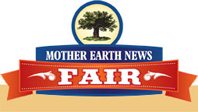 Visit us at
Visit us at
Mother Earth News Fair
Premier's booth #6604 & 6605
Asheville, NC
April 12-13, 2014
Premier's booth #1221 & 1320
Puyallup, WA
May 31-June 1, 2014
Premier's booth #151 & 153
Seven Springs, PA
September 12-14, 2014
Premier's booth -- TBA
Topeka, KS
October 25-26, 2014
PORTABLE HORSE FENCES
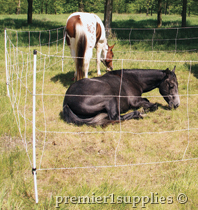
Horse QuikFence™ can be set up on the trail or at the show for a quick and secure horse paddock.
Horse QuikFence™ 4/48/24
What is it?
A ready-to-go electrifiable 4 ft tall mesh when installed. It’s suspended 1 ft above the soil. Line posts are already built into each roll. The unique plastic verticals (every 2 ft) are designed to break if a horse challenges the fence. Takes only minutes to install. View our Easy-To-Install Instructions
How large a fence energizer?
Most QuikFence fences need an energizer with 0.15 – 1.5 joules. See our Energizer Chart.
Are extra posts needed?
The built-in posts are adequate for line, curve and corner posts. But extra support at ends may be required. For this, use small wood or steel posts or string tied from the post tops back to tent pegs. FiberTuff™ Posts are also recommended for support.
Pros
| • |
Attractive, safe fence. |
| • |
Very visible. |
| • |
Effective, no-worry barrier. |
| • |
Installs with ease up and down hills, across valleys, around curves and next to trailers. |
| • |
Also stops cattle, camelids and most deer. |
| • |
Ideal for subdivision fences, semi-permanent boundary fences and as a weekend fence for shows and trail rides. |
Cons
| • |
Must be properly energized! |
ENERGIZER OPTIONS
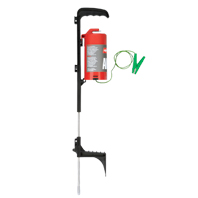
Useful for short (distance) horse fences that experience little grass contact.
Battery Option— Speedrite AN90
| • |
Peak output: 0.12 joules |
| • |
Pulses per minute: 38 |
| • |
6v/12v DC draw: 31 mA/hr |
| • |
Impedance type: low |
| • |
Input: (DC) 6v or 12v battery |
For temporary horse and cattle fences. Too small for netting fences. Has few equals for ease of use and portability.
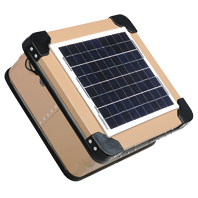
The PRS 50 comes ready to go and can be used with most horse fences (depending on length).
Solar Option—Premier PRS 50 Solar Energizer
| • |
Peak output: 0.5 joules |
| • |
Pulses per minute: 40 |
| • |
Impedance type: low |
| • |
Input type: solar |
Works anywhere in the 48 states because a 10-watt solar panel, if sited properly, is more than enough for this energizer.
For more information, view our Energizer Comparison Chart.
|
 |
 |
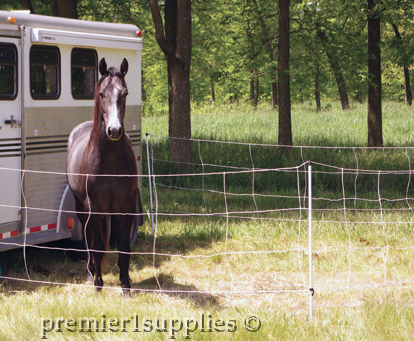
Horse QuikFence™ works easily to build trailer paddocks. End posts are tied (with nonconductive strings) to the trailer for support. Use the AN90 Energizer to energize the fence.
Simple Fence Solution—
Horse QuikFence™
At Premier the snow has finally disappeared from the hills and pastures while the mud is turning into something resembling solid ground. With the warm weather, a few of the folks at Premier are getting ready to saddle their horses and enjoy the fresh spring air. But before they do that, they'll need to check the status of their trailers (if they're hauling their horses), tack and horses.
Below are articles on trailer maintenance and safety, maximizing tack's lifespan and recommended equine vaccines. All three should help make your trail riding season enjoyable and trouble-free.
TRAILERING HORSES
Horse Trailer Maintenance and Trailering Safety
Marjorie R. Margentino, Former Program Associate in Animal Science
Karyn Malinowski, Ph.D., Director Equine Science Center
Carey A. Williams, Ph.D., Extension Specialist in Equine Management
Sara R. Malone, Department of Animal Sciences
Horse owners will usually find it necessary at some point in time to trailer their horses. Trailering may be necessary at time of purchase, for horse shows, trail riding, or a medical emergency. Whatever the need, it is important to be prepared and knowledgeable about trailering safety. Poor preparation of the horse, trailer or towing vehicle can turn a pleasurable outing into a horse owner’s nightmare. Poor truck and trailer maintenance can result in traffic accidents or breakdowns. In more extreme cases, broken welds can cause a trailer to become detached from the towing vehicle. Perhaps the most serious problem that can result from improper trailer upkeep is having a horse fall through rotted floorboards, especially during travel. This fact sheet will discuss the basic concerns involved in horse trailer maintenance and trailering safety.
When purchasing a horse trailer, consider the following needs:
| • |
First, when selecting a towing vehicle, it is important to make sure that the weight of the trailer and load horses) does not exceed that of the towing vehicle. Smaller pulling vehicles, like sport utility vehicles, have the power to “pull” the load but not to stop it, and often end up jack-knifed or in a ditch when the trailer pushes them down the road. |
| • |
Ample height (7-8 feet) and width (6-8 feet) for the horse(s) being hauled. |
| • |
Rubber mats on the floor and the loading ramp to provide traction and cushion during loading, unloading and travel. |
| • |
Tie ropes or chains of adequate length with quick release safety snaps. |
| • |
Adequate padding on chest bar and stall sides. |
| • |
Interior lights for night time hauling. |
| • |
Air vents on the roof and along side panels. Regular maintenance checks should be performed on a horse trailer every time it is used. Routine items include: |
| • |
Tires need a minimum amount of 1/4" of tread (check your state Division of Motor Vehicles for the measurement); they should be adequately inflated and have no signs of dry rot cracks. Spare tires also should be checked. |
Read More »
INCREASE TACK'S LIFESPAN
Top five tips to maximizing the life of your horse tack and equipment
Taking the time to properly care for your tack is essential to maximizing its life and usefulness!
Posted on February 11, 2014 by Taylor Fabus, Visiting Instructor
In order to maximize the useful life of your horse tack and equipment, you must properly maintain it. Tack and equipment costs can have a huge impact on your entire horse budget. Tack that is properly cared for not only lasts longer, but it can also prevent accidents and injury to both horse and rider. Read on to discover the top five ways to maximize the life of your tack and equipment.
| 1. |
Clean up your tack room. A crucial component of clean tack and equipment is your tack room. A clean, cool, and relatively dry room is ideal for maintaining the condition of your tack, especially leather. If your storage area is too humid, it can create an environment where mold can easily grow. Preventing this moist environment may require extra attention during Michigan’s humid summer months. Furthermore, it’s a good idea to scan your entire tack room on a weekly basis for excessive build-up of dust on rarely used tack, mold growth, or even pet or vermin droppings. Making this “scan” a weekly processes will make it a quick job! You’ll have little mess build up in a week’s time, so clean up won’t take long either. However, if you only do a cleanup of your tack room on a yearly basis, you’ll find the mess will be much larger and clean up time much longer. In addition, some messes (especially animal droppings) may have caused permanent damage to your tack. |
| 2. |
Tighten Up! This is a simple, yet oh-so important step. Set a schedule, say the 15th of each month, to go through your equipment to be sure things (like Chicago screws) are secure. |
This article was published by Michigan State University Extension. For more information, visit http://www.msue.msu.edu. To contact an expert in your area, visit http://expert.msue.msu.edu, or call 888-MSUE4MI (888-678-3464).
Read More »
SUGGESTED HORSE VACCINES
Equine Vaccinations: What Your Horse Really Needs
Pet Column for the week of February 1, 2010
Ashley Mitek, Information Specialists
University of Illinois at Urbana-Champaign, College of Veterinary Medicine
Source - Dennis D. French, DVM, DABVP
There's a vaccine for almost everything these days. From West Nile to strangles to sleeping sickness, it's easy to not be certain what vaccines are truly essential, which ones may be needed, and which ones are a waste of time (and money).
Dr. Dennis French is a veterinarian at the University of Illinois Veterinary Teaching Hospital in Urbana. He says that for the average backyard horse that does not travel, "there really are just four 'core' vaccines a horse needs each year." They are:
| • |
West Nile Virus (WNV) |
| • |
Tetanus |
| • |
Eastern and Western Encephalitis (EEE and WEE) |
| • |
Rabies |
Read More »
|
|